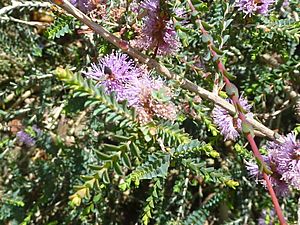Slender honey-myrtle facts for kids
Quick facts for kids Slender honey-myrtle |
|
|---|---|
 |
|
| M. gibbosa in Cambridge University Botanic Garden, England. | |
| Scientific classification | |
| Genus: |
Melaleuca
|
| Species: |
gibbosa
|
The Slender Honey-Myrtle (scientific name: Melaleuca gibbosa) is a cool plant from the myrtle family. It is also known as the small-leaved honey-myrtle. This plant grows naturally only in southern Australia. It is a thick, bushy shrub that can grow up to about 2 metres (6.6 feet) tall. It has many thin, arching branches. In spring, and sometimes throughout the year, it shows off lovely purple flower spikes.
Contents
What Does It Look Like?
The Slender Honey-Myrtle is a medium-sized shrub. It usually grows to be about 2 metres (6.6 feet) tall and wide. Its leaves are shaped like an egg. They are about 2 to 7 millimetres (0.08 to 0.28 inches) long and 2 to 4 millimetres (0.08 to 0.16 inches) wide. The leaves attach directly to the stem without a stalk. They are arranged in a special way, in crowded pairs that cross each other along the stem.
The flowers are a pretty purple colour. They grow in thick, cylinder-shaped spikes about 15 millimetres (0.59 inches) long. Each spike can have up to ten pairs of flowers. The stamens, which are the parts that hold pollen, are easy to see. They are about 3.5 to 5.5 millimetres (0.14 to 0.22 inches) long. They are grouped in five bundles around each flower. Each bundle has between 5 and 25 stamens. The flowers mostly appear in November and December. However, you can often see them at other times of the year too.
After the flowers, the plant produces woody seed pods called capsules. These capsules are about 5 millimetres (0.20 inches) across. They are wider at the bottom and become part of the woody stem. The seeds stay inside these capsules. They are only released when the plant, or that part of it, dies.
Where Did Its Name Come From?
The Slender Honey-Myrtle was first officially described in 1806. A French biologist named Jacques Labillardière gave it its scientific name. He wrote about it in his book, Novae Hollandiae Plantarum Specimen.
The second part of its scientific name, gibbosa, comes from a Latin word. Gibbosus means "humped" or "more swollen in one place than another". This name refers to the plant's sunken fruit. These fruits make the stems look a bit lumpy.
Where Does It Grow?
The Slender Honey-Myrtle grows along the coasts of South Australia, Victoria, and Tasmania. You can also find it on Kangaroo Island and Flinders Island.
It likes to grow in open, shrubby areas, especially in swampy places. It can be found from sea level up to about 1,500 metres (4,900 feet) high. This plant grows very well in windy, open spots. For example, you can see it thriving at Cape Bruny in southern Bruny Island and Hurricane Heath on the Tasman Peninsula.
Who Likes to Eat It?
This type of melaleuca plant provides food for some kinds of caterpillars. One example is the caterpillar of the tactile tuft-moth, called Aquita tactalis.
Can You Grow It?
If you want to grow the Slender Honey-Myrtle in your garden, it's a very tough plant. It can grow well in most types of soil and in different sunny or shady spots. It can handle dry weather and even frost. It also doesn't mind if the soil gets very wet.
You can easily grow new plants from seeds. Just collect the seeds from capsules that are one or two years old. You can also grow new plants from cuttings taken from semi-hard wood.



